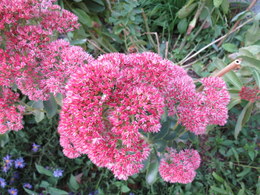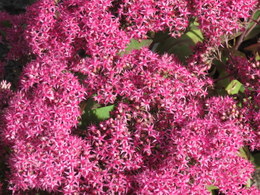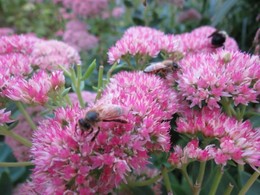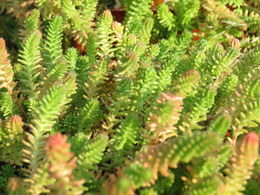Sedum-Stonecrop
Growing Guide
Sedum (Sedum spp.) also called stonecrop is a perennial native to Asia and will do well in USDA Zones 3 to 9. In its native wild environment, it was frequently found growing on rocky or stony ledges. Sedum is a succulent and tolerates drought conditions and is perfectly suited for rock gardens and is valued for its late fall season flowers.
The Sedum genus is in the family Crassulaceae, making up more than 600-species. Botanists, often using DNA, study plants in a large genus and decide if a plant should be in a new genus.
To keep things simple, it appears that the low growing creeping plants with small leaves will stay in the Sedum genus and the taller ones with large leaves and thick roots will be put into the new genus Hylotelephium. The Greek word “Hylo” means forest or woodland and "telephium" means distant lover. Botanists often use Latin or Greek in their plant descriptions.
The many hybrids made between the many species tends to complicate things. Plant growers are usually slow to adopt the new genus names and for now we will use the names that you will find in the garden centers.
The tall varieties will do best in full sun and come in shades of pink, rose, purple and burgundy. Bloom time is from the late summer to the fall. Depending on the variety they reach an average height of 14 to 24-inches and spread 15 to 18-inches.
The lower ground cover creeping sedum varieties range in height from 2 to 6-inches and spread 12 to 24-inches. They will do best in full sun, but can tolerate some light shade. These will spread slowly over time making attractive ground covering mats that will fill in those spaces between the rocks in your rock garden. They are also perfect as a border plant along a walkway in front of taller plants. They tend to bloom in midsummer in shades of yellow, white, or pink with succulent foliage ranging from green to a reddish bronze.
In addition to being deer resistant sedum are a nectar plant for butterflies and pollinators.
Starting From Seed
Follow the seed packet instructions. In general, they can be started indoors 6 to 8-weeks before your last expected frost date. Sow the seeds in a sterile seed starting mix in cell packs or pots. Do not cover the seeds, because they need light to germinate. Press lightly into the soil and keep moist.
Bottom watering is the easiest way to keep moist without disturbing the newly sown seeds. The seeds should germinate in 2 to 3-weeks. They can be transplanted into individual pots after the true leaves appear.
To harden off your plants put them outdoors when the temperature is in the 40s to the 50s. Put them in an area out of the direct sun and is sheltered from the wind for a few hours. Keep them watered and increase the time outdoors each day and allow them to get some direct sun. After about a week they can be left outdoors, but bring them indoors if frost threatens.
A cold frame is very useful in hardening off plants, making sure to open it up during the day or they could get burned from the heat of the hot sun. It can be closed at night if frost threatens and can protect your plants from animal damage. Hardening off prepares the plant for the outdoor environment and reduces transplant shock.
For more guidance our seed starting page will be helpful.
You can direct sow in your flower garden in the late spring to early summer. A large mass planting makes an impressive display.
Soil Preparation
Plant your Sedum in full sun in a nice loose well-drained garden soil. They will also do well in sandy, gravely well drained soils. As soon as the soil is frost-free and can be worked, till the soil by digging down 8 to 12-inches turning the soil over with a garden fork. Remove any large rocks, the small pebbles remaining will do no harm and actually benefit the soil by adding some micronutrients to the soil. It will tolerate most well drained soil conditions, but prefers a slightly acid soil.
When to Plant
Stonecrop should be planted in the late spring after the last expected frost. Plants in containers can be planted almost anytime right up to the early fall.
Planting Sedum-Stonecrop
Follow the grower’s instructions, but in general plant them 18 to 24-inches apart or in groups of 3 or 5 behind other shorter plants. Dig a hole as deep as the pot and twice as wide. To the soil you just removed add the same amount of good garden soil so you have a nice blend of new and native soil.
Take the plant out of the pot and gently loosen the root ball pulling away any roots that have grown in a circle around the pot.
Place the root ball in the hole with the growing crown of the plant even with or an inch higher than the surrounding soil. Gently spread out the roots and back fill the hole around the root ball leaving a shallow depression around your plant. Fill the depression with water to settle the soil around the roots adding more soil if necessary and water again. Water daily tapering off as the roots grow and get established.
Watering and Care
Sedum are very low maintenance and easy to care for. All you need to do is add a layer of mulch to help retain moisture and keep out competing weeds. They are drought tolerant and once established do not need much water except in drought conditions. They usually do not need any fertilizer, but a light side dressing of an organic fertilizer such as Espoma Plant-tone can be placed around the plant in the spring.
Diseases and Pests
Stonecrop are not generally affected by diseases, but occasionally aphids may appear. Small numbers do not cause serious harm and ladybug beetles usually control them. For heavy infestations an organic application of Bonide insecticidal soap or Bonide neem oil can be used. To help prevent in the future increase air circulation around the plants. Crowded conditions increase disease and pest problems.
Popular Sedum Varieties
Tall upright: Autumn Charm, Autumn Joy, Matrona, Monstead Dark Red, Neon.
Low Ground Cover: Angelina, Blue Spruce, Dragon's Blood, Frosty Morn, John Creech, October Daphne, Ogon, Purple Emperor, Tricolor, Vera Jameson.
Sources: American Meadows, Breck's, Park.
Garden Spikes newsletters give you timely information once or twice a month. Subscribe Free to the Garden Times newsletter below.
Your email address will only be used to send you a newsletter and will never be sold. You can unsubscribe at any time.




